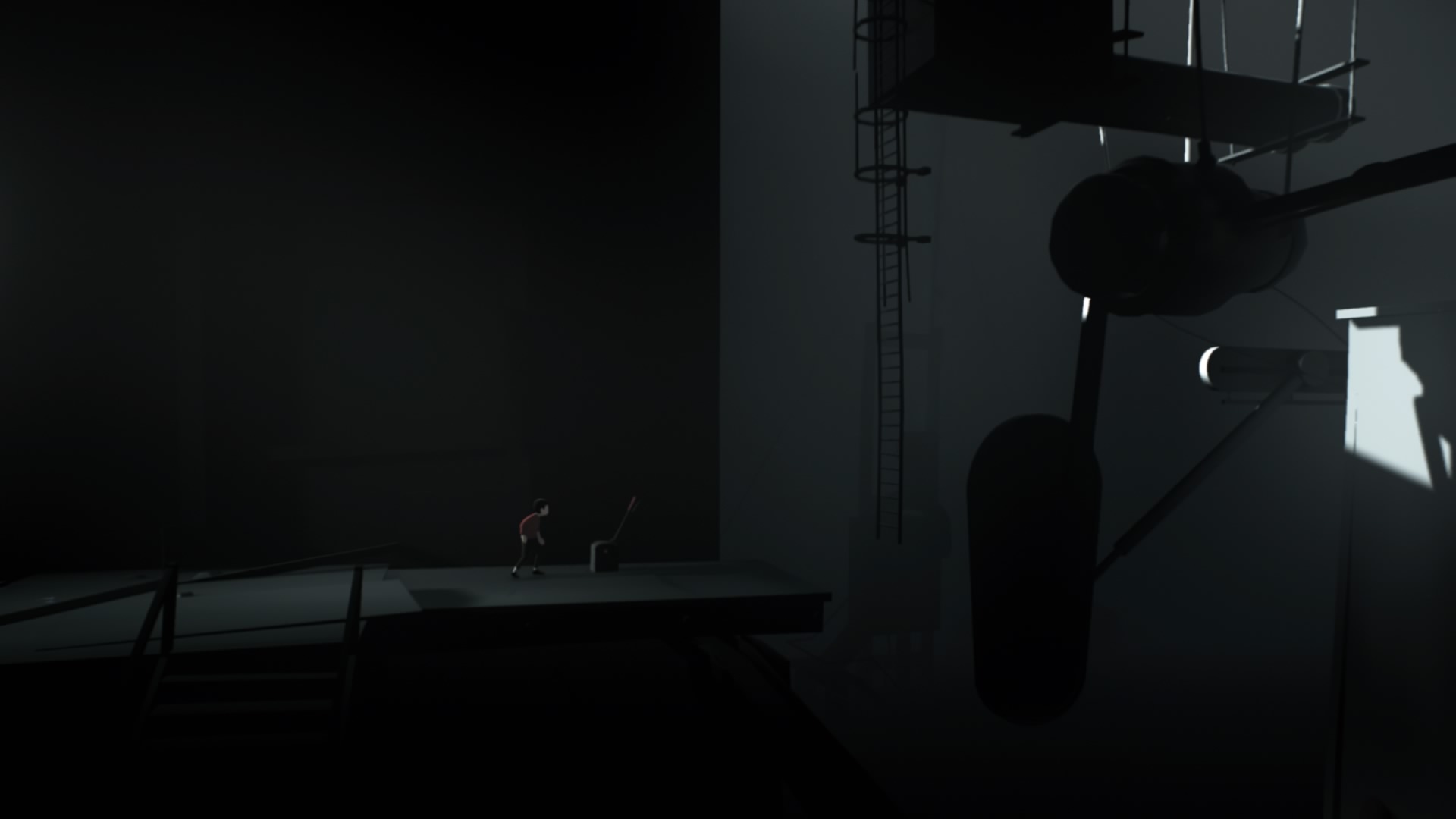Playdead’s 2016 release Inside makes use of audio in a number of interesting ways, but this article will focus on the sequence involving distant explosions and shockwaves. During this section a regularly repeating explosion in the background creates a rhythmic shockwave that moves from background to foreground, and the player must avoid being caught out in the open when the shockwave arrives. Failure to find cover results in a swift and graphic death as would be expected, but the manner in which Inside respawns the player is where it differs from many other games. Rather than simply revert the state of the entire game back to the way it was at the last checkpoint, Inside allows the repeating sound of the shockwave to continue, and respawns the player at an appropriate time within the cycle. This audio-led system has a number of implications regarding the function of audio within this section of the game, which will be detailed in this article.
Ludic Functionality
The most immediate function that the audio serves is to instruct the player on how to approach this section of gameplay. The sound of the shockwave is loud and has a large amount of low frequency content. It also causes the ambient sound of the level to duck when it occurs, which increases the perceived loudness of the sound. This all communicates to the player that the shockwave is a threat to them, even before it has resulted in death for the first time, and prompts the player to ensure they are behind cover when the shockwave arrives.
The shockwave is preceded by a rising sound similar to that of a falling explosive shell and a muffled explosion. The delay between the explosion and the shockwave also conveys some spatial information about the game environment, as it creates the impression that the explosion must be occurring very far away in order for the shockwave to take so long to arrive. This is of course physically impossible, in reality the sound of the explosion and the shockwave are one and the same, but the effect is very convincing nonetheless.
This sequence of sounds allows the player to time their movement between cover objects and avoid a fail state (death). As the cycle of warning sound, explosion, shockwave repeats, it establishes a rhythm in the player’s mind. The player may then rely on this internal sense of rhythm to overcome the puzzles in the section rather than simply relying on a more literal interpretation of the sound cues to avoid danger. If the player was simply waiting for the sound of an incoming explosive shell to denote imminent danger before moving to safety, some of the sections’s puzzles would be much more difficult. One in particular involves using a heavy door as movable cover, and due to its momentum or lack thereof the player must pre-empt the warning cue with their movement input in order to be successful. These kinds of puzzles are solvable only by paying attention to the rhythmic nature of the audio, so a respawn system that breaks the rhythmic continuity could easily lead to player frustration or confusion. In keeping the rhythmic continuity in tact throughout death and respawning, Inside not only avoids player frustration but also continually conditions the player to listen to the audio cues and respond accordingly. This appears to have been one of Playdead’s key motivators in designing this section. Sound designer Martin Stig Andersen states in Inside: A Game That Listens (2016) that a similar section in their previous release Limbo was compromised due to the fact that the audio would not loop continuously, making the puzzle harder to solve. When creating Inside they designed it from the ground up to allow for continuously looping audio.
The rhythmic nature of the gameplay allows for parallels to be drawn with rhythm action games such as Guitar Hero and Rock Band. In Inside however it is not a player’s reflexes and hand eye co-ordination skills that are challenged through the use of rhythmic gameplay, but rather their ability to plan and judge speed, distance and positioning. Technically the sound of the shockwave could also be considered a game mechanic in and of itself due to the fact that the player is attempting to avoid being destroyed by a very large wave of air pressure.
Immersive Functionality
The constantly looping audio cues in this section also have implications for player immersion. Collins (2008 p. 134) states that “Audio plays a significant role in the immersive quality of a game. Any kind of interruption in gameplay – from drops in frame rate playback or sluggish interface reactions – distracts the player and detracts from the immersion and from audio’s playback – particularly interruptions in music such as hard cut transitions between cues”. If the audio were to simply stop at the point of death and start again when the player respawned, it would create exactly the kind of discontinuity that Collins mentions here and have a detrimental effect on player immersion. Ermi and Mayra (2005 pp. 7-8) delineate immersion into two main categories; sensory immersion as created by the graphics and audio of the game, and challenge-based immersion created by the player applying their skills to overcome the game’s challenges. Death and respawn mechanics present a unique challenge in terms of preserving both sensory and challenged-based immersion. Upon dying the player has triggered a fail state and no longer has physical control of the character. This interrupts the challenge-based immersion until the player respawns and regains agency. Furthermore the game will usually have to reset itself back to a previous checkpoint. This most likely means fading the audio out and fading the screen to black, breaking sensory immersion through lack of audio visual input. By continuing to loop the shockwave sound effects even after the player dies, Inside retains auditory immersion throughout, keeping the player immersed until they are respawned and challenge-based immersion can resume.

This section the game is not solely notable for its sound design, as the music implementation also plays a key role. There is a puzzle part way through the section where the player is required to synchronise a piece of cover that moves in a circular pattern with the rhythm of the shockwave. If the player is successful then the cover will move across a ladder at just the right time to protect the player as they ascend it. By its very nature the puzzle can be a difficult one to solve, and the game provides a clear signifier to the player when they achieve the solution by removing the shockwave sound design entirely and replacing it with a musical cue that follows the same rhythmic pattern. First and foremost this notifies the player that they have solved the puzzle, but it has a much more profound effect in terms of player immersion. The game makes an explicit shift from realistic sensory immersion to abstract sensory immersion. With the more literal sounds of the threat removed the player is now focussed solely on timing their movements to the rhythm rather than taking cover from an explosion. Grau (2003 p.13) states that “…immersion is mentally absorbing and a process, a change, a passage from one mental state to another. It is characterize by a diminishing critical distance to what is shown and an increasing emotional involvement in what is happening.” Inside almost forces the player into a deeper state of immersion by engineering this change from sound effects to emotionally engaging music in a very sudden and unexpected way and inducing a different mood. As Collins (2008 p. 133) states “Mood induction and physiological responses are typically experienced most obviously when the player’s character is at significant risk of peril… In this way, sound works to control or manipulate the player’s emotions, guiding responses to the game.” The timing of this shift in mood occurs when the player is in the middle of a fairly stressful section. The only way out of this hostile environment is to progress, and at the exact moment the musical cue enters the player is halfway up a ladder, exposed until the last moment when the cover swings into place to protect them. Due to the stressful nature of this predicament the mood induction can be highly effective, arriving at the precise moment the player experiences the relief of solving the puzzle and the endorphin rush of a reward for competency.
As the player progresses from this point, higher pitched reverberant synth layers gradually fade into the mix, drawing the player deeper into the abstract soundscape and even further from the literal auditory events of the scene. Once the player has completed the section, the pulsing, rhythmic synth layers representing the danger of the shockwave fade out entirely, leaving only the nebulous higher pitched synth layers. This serves to notify the player that the danger has passed, and that they can proceed normally from here on. Once the player enters the elevator at the very end of the section, the music fades out entirely, before the shockwave sounds return suddenly and cause the elevator to crash into the water below. This final subversion of expectations catches the player unaware and serves to bring them back to the game’s more literal reality very suddenly. This unexpected tonal shift creates feelings of stress in the player, setting them up for the next mood induction which comes in the form of a claustrophobic underwater gameplay section.
In conclusion, Inside utilises audio in this gameplay section to imbue one fairly simple mechanic with a number of different functions. By giving priority to the looping audio and ensuring that all other gameplay elements conform appropriately, Inside is able to effectively communicate the game mechanics whilst retaining and deepening player immersion, even through repeated player deaths.
REFERENCES
Andersen M. (2016) Inside: A Game That Listens. [Online Video] Available at https://www.youtube.com/watch?v=Dnd74MQMQ-E [Accessed 4th Feb 2018].
Collins, K. (2008) Game Sound: An Introduction to the History, Theory and Practice of Video Game Music and Sound Design. Cambridge (MA): The MIT Press.
Grau, O. (2003) Virtual Art: From Illusion to Immersion. Cambridge (MA): The MIT Press.
Ermi, L. and Mayra, F. (2005) Fundamental Components of the Gameplay Experience: Analysing Immersion. DiGRA ’05 – Proceedings of the 2005 DiGRA International Conference: Changing Views: Worlds In Play.
